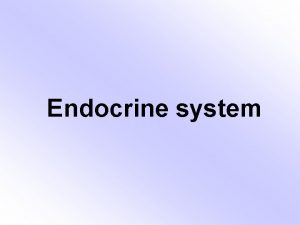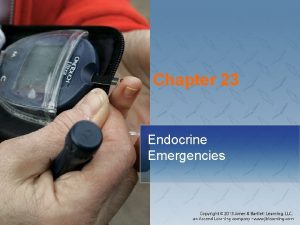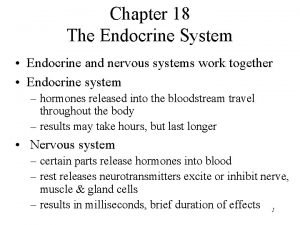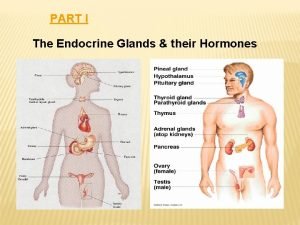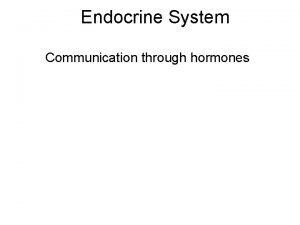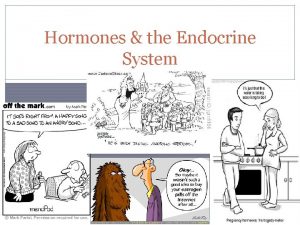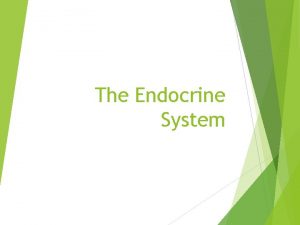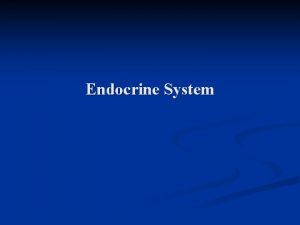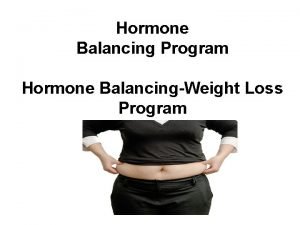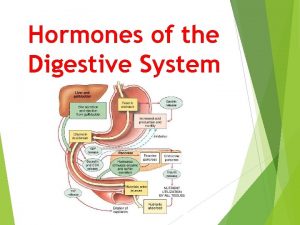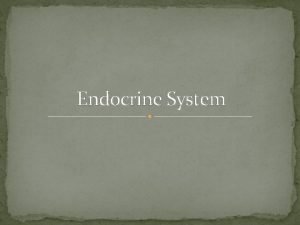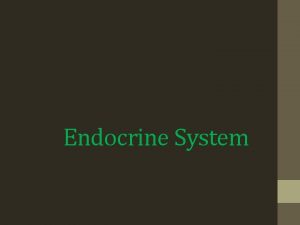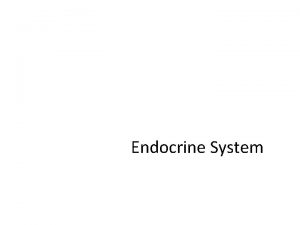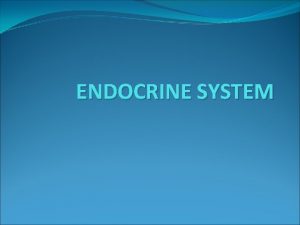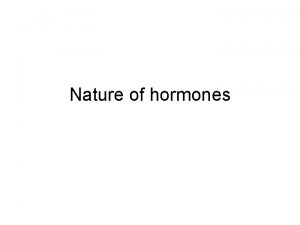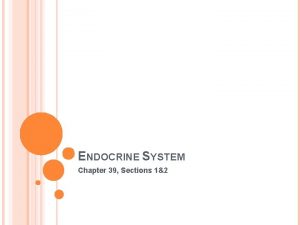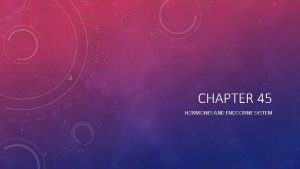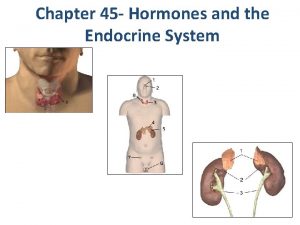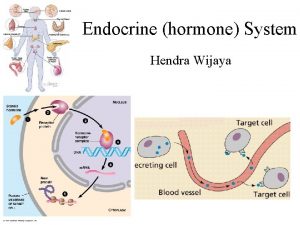Endocrine System Chapter 45 Hormones a hormone is


















- Slides: 18

Endocrine System Chapter 45

Hormones • a hormone is a chemical signal that is released in one part of the body & travels to another part of the body (through the circulatory system) where it elicits a particular response in the target cells • 3 major classes of hormones: water-soluble; tend to bind to – proteins & peptides receptor proteins on cell surface – amines of target cells – steroids: lipid-soluble; tend to bind to cytoplasmic receptors inside target cells

Simple Endocrine Pathway • a signal molecule (stimulus) binds to a receptor protein on an endocrine cell which triggers the release of hormones • hormones travel through blood stream to effector cells, eliciting a response

Simple Neurohormonal Pathway • endocrine gland receives a stimulus from a sensory neuron which triggers the release of hormones • hormones travel through blood stream to effector cells, eliciting a response

Simple Neuroendocrine Pathway • endocrine gland receives a stimulus from a sensory neuron which triggers the release of hormones • hormones travel through blood stream & bind to receptor proteins on endocrine cells of another endocrine gland which triggers the release of a second hormone • this hormone travels through the blood stream to effector cells, eliciting a response

Feedback Loops • Negative Feedback Loops – effector response reduces the initial stimulus thereby preventing overreaction • Positive Feedback Loops – effector response reinforces the initial stimulus thereby leading to an even greater response

Events of Hormonal Signaling • reception – the binding of a signal molecule to a receptor protein on/in a target cell • signal transduction – the series of events in the cell triggered by the binding a signal molecule to a receptor protein • response – the change in cell behavior as a result of the signal transduction pathway – gene transcription, enzyme activation, change in uptake/secretion of specific molecules, rearrangement of the cytoskeleton *Review Chapter 11

Human Endocrine Glands • hypothalamus • pineal gland • anterior & posterior pituitary glands • thyroid gland • parathyroid glands • adrenal glands (cortex & medulla) • pancreas • gonads (ovaries, testes)

Hypothalamus • bridge between the endocrine & nervous systems – acts as part of the nervous system when it sends electrical signals to the adrenal gland to release adrenaline during times of stress – acts like a nerve when it secretes gonadotropicreleasing hormone which stimulates the anterior pituitary to release FSH & LH – acts as an endocrine gland when it produces oxytocin & ADH that it stores in the posterior pituitary • contains the body’s thermostat • contains centers for regulating hunger & thirst

hypothalamus posterior pituitary anterior pituitary

Pituitary Gland • anterior pituitary – synthesizes & secretes several hormones – FSH & LH: stimulate activities ovaries & testes – TSH: promotes normal thyroid development – ACTH: stimulates adrenal cortex to produce & secrete steroid hormones – GH: stimulates bone growth • posterior pituitary – stores & secretes 2 hormones made in hypothalamus – oxytocin: stimulates uterine contractions & mammary glands – ADH: promotes water-retention by kidneys

Pineal Gland • located near the center of the brain • releases melatonin which is involved in biological rhythms regulated by light & dark cycles

Thyroid Gland • located on trachea • produces… – thyroxine: controls metabolic rate – calcitonin: lowers blood calcium levels

Parathyroid Glands • located on the surface of the thyroid gland • releases parathyroid hormone (PTH) – raises blood calcium levels – counteracts effect of calcitonin


Adrenal Glands • located above the kidneys • adrenal medulla releases epinephrine (adrenaline) & norepinephrine (noradrenaline) – involved in the fight-or-flight response (short-term stress response) – raises blood sugar level by increasing rate of glycogen breakdown by the liver • adrenal cortex releases glucocorticoids – involved in long-term stress response – raises blood sugar level

Pancreas • releases… – insulin: lowers blood glucose levels – glucagon: raises blood glucose levels

Gonads • ovaries (females) – estrogens: maintenance of the female reproductive system & development of secondary sex characteristics; stimulate uterine lining growth – progesterone: promote uterine lining growth • testes (males) – androgens (ex: testosterone): maintenance of the male reproductive system & development of secondary sex characteristics; aid in sperm formation
 Tropic hormones hypothalamus
Tropic hormones hypothalamus Hormones
Hormones Pars intermedia
Pars intermedia Hypothalamus gland
Hypothalamus gland Endocrine system and reproductive system
Endocrine system and reproductive system Endocrine system and nervous system
Endocrine system and nervous system Lympathic
Lympathic Nervous system vs endocrine system venn diagram
Nervous system vs endocrine system venn diagram Endocrine system and nervous system
Endocrine system and nervous system Chapter 16
Chapter 16 Chapter 7 13 endocrine system
Chapter 7 13 endocrine system Hypothal
Hypothal Chapter 23 the endocrine system
Chapter 23 the endocrine system Chapter 16 lesson 3 the female reproductive system
Chapter 16 lesson 3 the female reproductive system Lipid soluble hormones examples
Lipid soluble hormones examples Reproductive physiology
Reproductive physiology Adenohypophysis
Adenohypophysis Sympathetic nervous system
Sympathetic nervous system Comparison of endocrine and nervous system
Comparison of endocrine and nervous system


